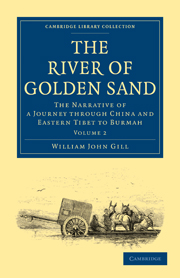Book contents
- Frontmatter
- Contents
- ILLUSTRATIONS and MAPS to VOL. II
- CHAPTER I ‘A RICH AND NOBLE CITY’
- CHAPTER II THE ANCIENT MARCHES OF TIBET
- CHAPTER III ‘THE ARROW FURNACE FORGE’
- CHAPTER IV THE GREAT PLATEAU
- CHAPTER V THE GREAT PLATEAU–continued
- CHAPTER VI REGION OF THE RIVER OF GOLDEN SAND
- CHAPTER VII REGION OF THE RIVER OF GOLDEN SAND—Continued
- CHAPTER VIII IN THE FOOTSTEPS OF MARCO POLO AND OF AUGUSTUS MARGARY
- CHAPTER IX IN THE FOOTSTEPS OF MARCO POLO AND OF AUGUSTUS MARGARY—continued
- APPENDIX A
- APPENDIX B
- APPENDIX C
- INDEX
- Plate section
CHAPTER II - THE ANCIENT MARCHES OF TIBET
Published online by Cambridge University Press: 07 September 2011
- Frontmatter
- Contents
- ILLUSTRATIONS and MAPS to VOL. II
- CHAPTER I ‘A RICH AND NOBLE CITY’
- CHAPTER II THE ANCIENT MARCHES OF TIBET
- CHAPTER III ‘THE ARROW FURNACE FORGE’
- CHAPTER IV THE GREAT PLATEAU
- CHAPTER V THE GREAT PLATEAU–continued
- CHAPTER VI REGION OF THE RIVER OF GOLDEN SAND
- CHAPTER VII REGION OF THE RIVER OF GOLDEN SAND—Continued
- CHAPTER VIII IN THE FOOTSTEPS OF MARCO POLO AND OF AUGUSTUS MARGARY
- CHAPTER IX IN THE FOOTSTEPS OF MARCO POLO AND OF AUGUSTUS MARGARY—continued
- APPENDIX A
- APPENDIX B
- APPENDIX C
- INDEX
- Plate section
Summary
July 10.—The march to Shuang-Liu was over the busy, fertile plain, entirely given up to rice-cultivation. In the gardens there were melons, cucumbers, all sorts of vegetables, and patches of Indian corn. The country was beautifully watered; little rills brimming with water coursing by the road-side, or among the fields; and, as elsewhere on this plain, there were numerous detached farmhouses embowered in trees and bamboos.
The road was crowded with coolies and passengers proceeding in both directions, and the number of tea-houses was in proportion.
At the end of our journey Chin-Tai told me with a melancholy smile that he could buy neither fish, flesh, fowl, nor eggs, and wanted to know what I should like for dinner.
The fast was now being kept very religiously, and the south gates of all the cities were shut.
In China, wood forms a very large proportion of the material used in the construction of houses. After a continuance of hot and dry weather, the timber-work having been baked day after day is like tinder, and would blaze up on the slightest provocation. A fire would soon spread over a town, and with the inadequate means at disposal for extinguishing it, the damage would be very great. Fires are therefore intensely dreaded during a drought, and as it is supposed that the fire-god can only enter by the south gates of the cities, these are kept closely shut.
- Type
- Chapter
- Information
- The River of Golden SandThe Narrative of a Journey through China and Eastern Tibet to Burmah, pp. 37 - 75Publisher: Cambridge University PressPrint publication year: 2010First published in: 1880



